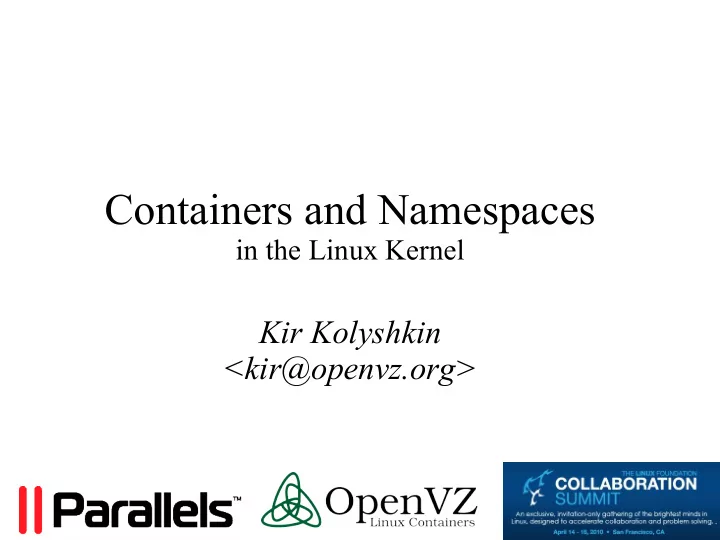

Containers and Namespaces in the Linux Kernel Kir Kolyshkin <kir@openvz.org>
Agenda Containers vs Hypervisors Kernel components – Namespaces – Resource management – Checkpoint/restart 2
Hypervisors VMware Xen Parallels UML (User Mode Linux) QEmu Bochs KVM 3
Containers OpenVZ / Parallels Containers FreeBSD jails Linux-VServer Solaris Containers/Zones IBM AIX6 WPARs (Workload Partitions) 4
Comparison Containers (CT) Hypervisor (VM) One real HW (no virtual One real HW, many virtual HWs, many OSs HW), one kernel, many userspace instances High versatility – can run High density different OSs Lower density, Dynamic resource performance, scalability allocation «Lowers» are mitigated by Native performance: new hardware features [almost] no overhead (such as VT-D) 5
Comparison: a KVM hoster 6
Comparison: bike vs car Feature Bike Car Ecological Yes No Low price Low High Needs parking space No Yes Periodical maintenance cost Low Med Needs refuelling No Yes Can drive on a footpath Yes No Lightweight aluminium frame Yes No Easy to carry (e.g. take with you on a train) Yes No Fun factor High Low Source: http://wiki.openvz.org/Bike_vs_car 7
Comparison: car vs bike Feature Car Bike Speed High Low Needs muscle power No Yes Passenger and load capacity Med Low In-vehicle music Yes No Gearbox Auto Man Power steering, ABS, ESP, TSC Yes No Ability to have sex inside Yes No Air conditioning Yes No Fun factor High Low Source: http://wiki.openvz.org/Car_vs_Bike 8
OpenVZ vs. Xen from HP labs For all the configuration and workloads we have tested, Xen incurs higher virtualization overhead than OpenVZ does For all the cases tested, the virtualization overhead observed in OpenVZ is limited, and can be neglected in many scenarios Xen systems becomes overloaded when hosting four instances of RUBiS, while the OpenVZ system should be able to host at least six without being overloaded 9
You can have both! • Create containers and VMs on the same box • Best of both worlds 10
11
Kernel components • Namespaces – PID – Net – User – IPC – etc. • Resource management (group-based) • Fancy tricks – checkpoint/restart 12
Trivial namespace cases • Filesystem: chroot() syscall • Hostname: struct system_utsname per container CLONE_NEWUTS flag for clone() syscall 13
PID namespace: why? • Usually a PID is an arbitrary number • Two special cases: – Init (i.e. child reaper) has a PID of 1 – Can't change PID (process migration) 14
PID NS: details • clone(CLONE_NEWPID) • Each task inside pidns has 2 pids • Child reaper is virtualized • /proc/$PID/* is virtualized • Multilevel: can create nested pidns – slower on fork() where level > 1 • Consequence: PID is no longer unique in kernel 15
Network namespace: why? • Various network devices • IP addresses • Routing rules • Netfilter rules • Sockets • Timewait buckets, bind buckets • Routing cache • Other internal stuff 16
NET NS: devices • macvlan – same NIC, different MAC – NIC is in promisc mode • veth – like a pipe, created in pairs, 2 ends, 2 devices – one end goes to NS, other is bridged to real eth • venet (not in mainstream yet / only in OpenVZ) – MACless device – IP is ARP announced on the eth – host system acts as a router 17
NET NS: dive into • Can put a network device into netns – ip link set DEVICE netns PID • Can put a process into netns – New: clone(CLONE_NEWNET) – Existing: fd = nsfd(NS_NET, pid); setns(fd); 18
Other namespaces • User: UIDs/GIDs – Not finished: signal code, VFS inode ownership • IPC: shmem, semaphores, msg queues 19
Namespace problems / todo • Missing namespaces: tty, fuse, binfmt_misc • Identifying a namespace – No namespace ID, just process(es) • Entering existing namespaces – problem: no way to enter existing NS – proposal: fd=nsfd(NS, PID); setns(fd); – problem: can't enter pidns with current task – proposal: clone_at() with additional PID argument 20
Resource Management ● Traditional stuff (ulimit etc.) sucks – all limits are per-process except for numproc – some limits are absent, some are not working Answer is CGroups – a generic mechanism to group tasks together – different resource controllers can be applied Resource controllers – Memory / disk / CPU … – work in progress 21
Resource management: OpenVZ • User Beancounters a set of per-CT resource counters, limits, and guarantees • Fair CPU scheduler two-level shares, hard limits, VCPU affinity • Disk quota two-level: per-CT and per-UGID inside CT • Disk I/O priority per CT 22
Kernel: Checkpointing/Migration Complete CT state can be saved in a file − running processes − opened files − network connections, buffers, backlogs, etc. − memory segments CT state can be restored later CT can be restored on a different server 23
LXC vs OpenVZ • OpenVZ was off-the-mainline historically – developing since 2000 • We are working on merging bits and pieces • Code in mainline is used by OpenVZ – It is also used by LXC (and Linux-VServer) • OpenVZ is production ready and stable • LXC is a work-in-progress – not a ready replacement for OpenVZ • We will keep maintaining OpenVZ for a while 24
Questions / Contacts kir@openvz.org containers@linux-foundation.org http://wiki.openvz.org/ http://lxc.sf.net/ 25
To sum it up Platform-independent − as long as Linux supports it, we support it No problems with scalability or disk I/O − lots of memory, lots of CPUs no prob − native I/O speed Best possible performance Plays well with others (Xen, KVM, VMware) 26
[Backup] Usage Scenarios Server Consolidation Hosting Development and Testing Security Educational 27
Recommend
More recommend